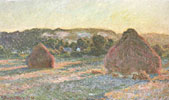 |
THE MEADOW SCENE |
 |
More connections to Monet's paintings
-
Just like our
‘Meadow scene’ the next painting is a Pochade or Esquisse: ‘Le
Promenade’, 1886, (W.1075), 102x75 cm. Unsigned, though
stamped with the signature, which means that it stayed in Monet’s
atelier until his death. He certainly did not consider it as
finished. It was most probably kept only because of the motif – a
family portrait. We also recognise it in some photos from the
atelier. Suzanne is the figure in the centre, (second from the
left). Her long hair is blowing in the wind. We feel very much
acquainted with the palette from all our three paintings. We could
also call this a ‘Snap shot’. It is left in a more unfinished
state than the ‘Meadow scene’. Perhaps Monet spent just as long
time on both of them?
-
Our ’Meadow-scene’
is more detailed and feels more sensitive. Let us go further and
study some details being important for the composition:
-
The circle
of the hat plays an
important part in
the picture. The hat is painted like a shield, creating distance
to the spectator and giving a 3D- effect to the subject. Please
compare the circle of the hoop hold by the nursemaid in ‘Camille
in the garden with Jean’; 1873, (W 280), look how she
holds it in front of her, it gives the same 3D-feeling as the
hat, (and here we furthermore have the
‘looking-through-effect’). The parasol is as we know one
of Monet´s most beloved subjects creating depth and a stop for
our eyes.

Wheat-stacks, (End of Summer)
-
The
variegation of the meadow, divided into fields of shadow and
sun. This is very much like the sun and shadow effect in the
painting ‘Wheat-stacks,
(End of Summer)’, 1890-91, (W 1269).
-
‘Le
Signal’, (‘Track Signals outside Saint-Lazare Station’),
1877, (W448), 65x81, Niedersächsisches Landesmuseum, Hanover. This
painting is of great interest for us of two reasons. We just
mentioned one of them: the Hat painted like a shield/circle/disc.
Here it is again, the circle, sucking our eyes, giving the same
3D-effect. Here we also have the same kind of feverish, hasty
brush work. The most important circle in the ouevre of Claude
Monet is the Sun – do not forget ‘Impression, Soleil levant’.
(Here we certainly can talk of the 3D-effect, though we mainly
have it in our minds. Monet was fully aware of this, and this is
also what ‘Impressionism’ is about!)
Before leaving
Le Signal we must observe a most curious fact, concerning the
preparation of the canvas. If we look at the upper part to the
left of the upper signal, we can easily see the structure of the
canvas. It is like a black was laid
directly on the canvas.
Can you see it? You can follow it along the upper part, out to the
house on the left hand side. What is so interesting about this?

Click for detail comparison
You will get
the answer if you turn back to our ‘River-scene’.
Here the same black appears in the centre, ‘under the water’,
between the girl and the landing-stage!! I have had the
possibility to compare these paintings side by side in the Museum
at Hanover and what I found was: it is exactly the same curious
black underlayer! Is this what is
known as "the turbid medium effect"? Perhaps
somebody knows something about this - and can give an explanation?
Do You? Please let me know! I am of course deeply grateful for all
information – even if it should seem to be of little importance -
it might be just that little missing piece in this huge jig-saw!
Perhaps you have seen this black in other paintings by Monet?
Don’t hesitate – please send
me an e-mail.
» Next:
Summary
|
|